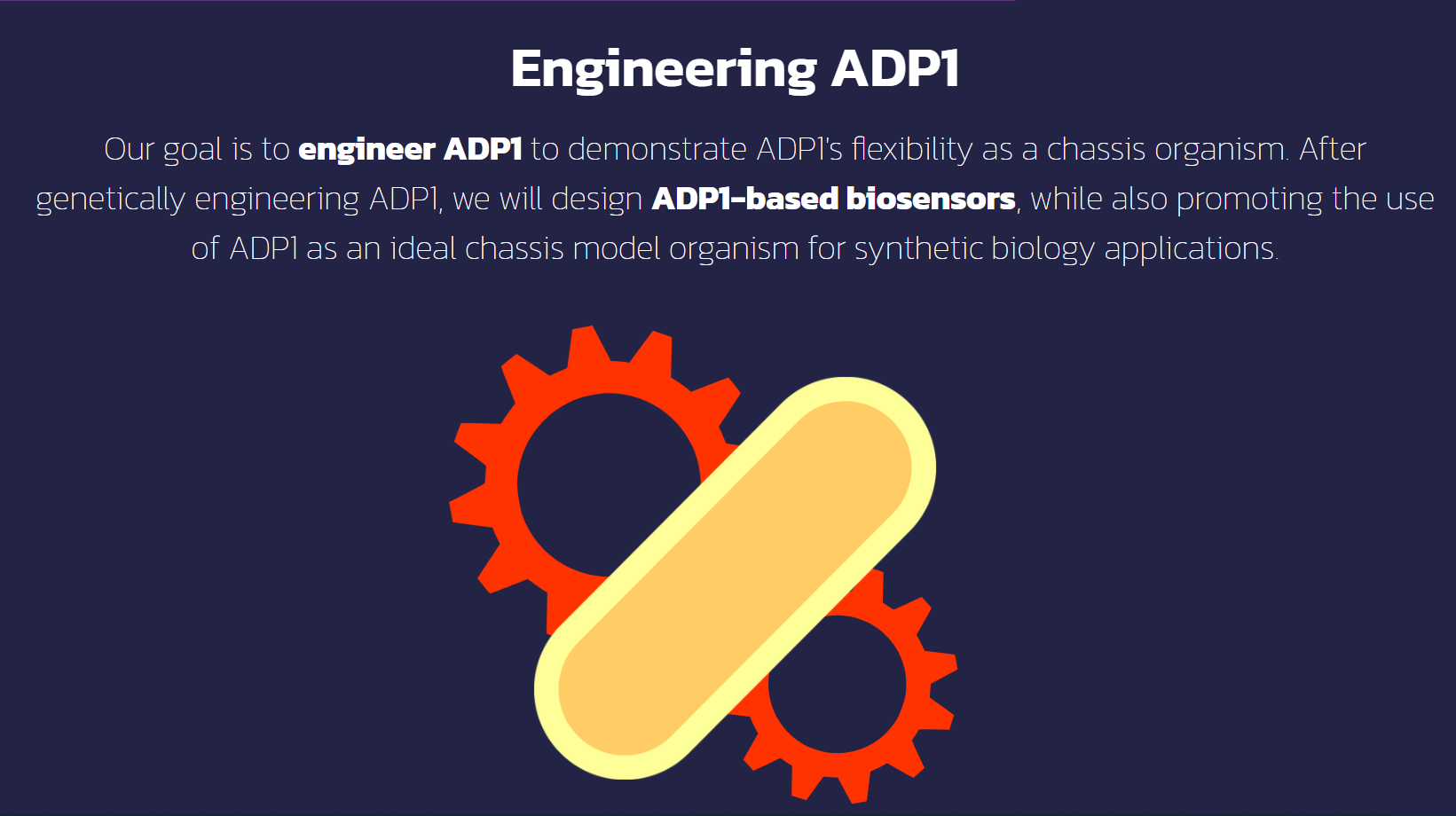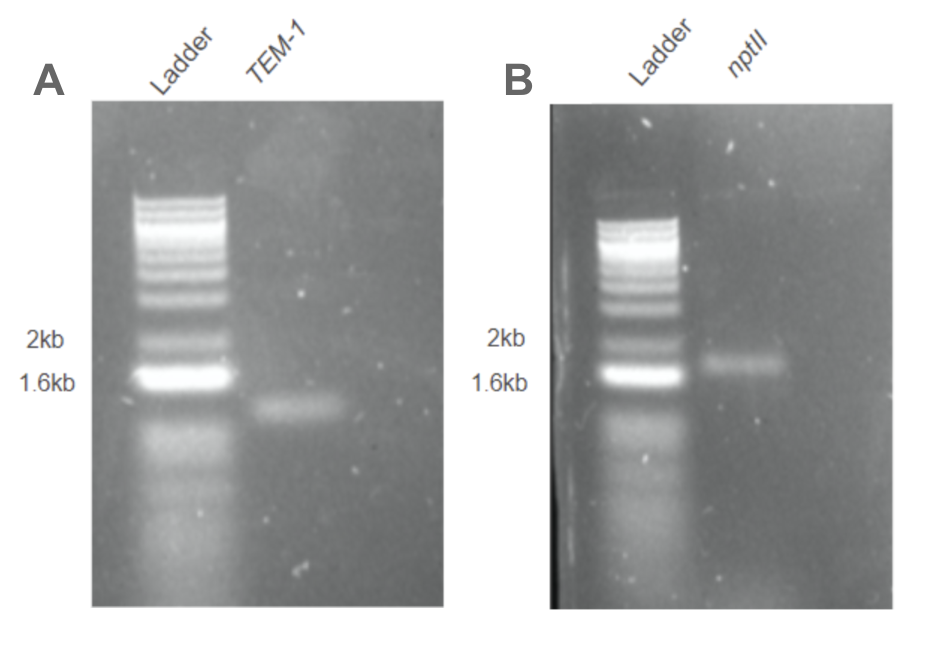Part:BBa_K4342015
nptII Broken Gene
Introduction
The 2022 UT Austin iGEM Team’s Part Collection provides a number of DNA sequences and procedures for genetically engineering Acinetobacter baylyi ADP1. We were able to effectively engineer ADP1's genome using a two-step genetic engineering protocol. See the Engineering Page for more details on how we modified ADP1's genome. On this page, we explain how our part collection can be used alongside this two-step protocol to delete ADP1 genes, insert DNA sequences into any chromosomal location, and engineer an ADP1-based biosensor to detect any DNA sequence of interest.
We hope this part collection guides future iGEM teams in engineering ADP1 and utilizing ADP1’s flexibility to tackle any challenge in synthetic biology.
Categorization
For our parts collection, we categorize our parts into the following categories:
Upstream
An Upstream basic part is a DNA sequence directly upstream of a target gene. These basic parts are homology flanks that are used for ADP1 Genetic Engineering. Examples include the ACIAD2049 Upstream for P. destructans detector (BBa_4342003) and pbpG Upstream (BBa_4342011).
Downstream
A Downstream basic part is a DNA sequence directly downstream of a target gene. These basic parts are homology flanks that are used for ADP1 Genetic Engineering. Examples include ACIAD2049 Downstream for P. destructans detector (BBa_4342004) and pbpG Downstream (BBa_4342012).
Integration Cassettes
An "Integration" cassette is a composite part consisting of an "Upstream" basic part, the tdk/kan basic part (BBa_4342000), and a "Downstream" basic part. These parts are designed to use in the first transformation step in ADP1 Genetic Engineering. Examples include the ACIAD2049 Integration cassette (BBa_4342019) and the acrB Integration cassette (BBa_4342023).
Rescue Cassettes
"Rescue" cassette is a composite part consisting of an "Upstream" basic part, an optional genetic device, and a "Downstream" basic part. These parts are designed to use in the second transformation step in ADP1 Genetic Engineering. Examples include the ACIAD2049 Rescue cassette (BBa_4342020, Upstream + Downstream), the YFP Rescue cassette (BBa_4342030, Upstream + Genetic Device + Downstream), and the nptII Detector Rescue cassette (BBa_4342031, Upstream + Composite Part + Downstream).
Genetic Device
"Genetic Device" is a basic part that can be any DNA sequence to be integrated into ADP1. Examples include the CymR YFP (BBa_4342008) and the nptII Broken Gene (BBa_4342015).
We further categorize each part with a standardized Golden Gate Assembly (GGA) Type 1-8 Overhang [2]. Each type is ligated to a complementary type (ex. Type 2 can be ligated to Type 1 and Type 3). Moreover, some parts contain consecutive GGA Type numbers, such as Type 234. These DNA sequences start with a Type 2 Overhang and end with a Type 4 Overhang (ex. tdk/kan cassette (BBa_4342000).
Usage and Biology
The nptII gene in Acinetobacter baylyi ADP1 codes for kanamycin antibiotic resistance. Deleting a section of this gene prevents ADP1 from growing on kanamycin antibiotic, making ADP1 susceptible to this antibiotic. This allows for the detection of homologous recombination/transformation of the correct nptII antibiotic resistance gene by AdDP1.
Design
The nptII broken gene part comprises the 1583 base pair region that contains the deactivated nptII gene in ADP1. This part has BsaI restriction sites attached to the 5’ end and the 3’ end, which are specifically designed to allow for the detection of a functional nptII gene through a two-step process involving selection and counterselection.
BsaI Restriction Site
The BsaI site is designed to ligate to the 3’ end of the ACIAD2049 Upstream (BBa_4342001) and the 5' end of the ACIAD2049 Downstream (BBa_4342002) creating the nptII detector construct composite part (BBa_4342031). This composite part permits the selection of transformants through kanamycin resistance.
Characterization
References
[1] De Vries, J., Wackernagel, W. (1998). Detection of nptII (kanamycin resistance) genes in genomes of transgenic plants by marker-rescue transformation. Molecular and General Genetics, 257, 606-613. https://doi.org/10.1007/s004380050688
[2] Kong, K., Schneper, L., Mathee, K. (2010). Beta-lactam Antibiotics: From Antibiosis to Resistance and Bacteriology. APMIS, 118(1), 1-36. https://doi.org/10.1111/j.1600-0463.2009.02463.x
- 10INCOMPATIBLE WITH RFC[10]Illegal XbaI site found at 44
Illegal XbaI site found at 1256
Illegal PstI site found at 22
Illegal PstI site found at 609 - 12INCOMPATIBLE WITH RFC[12]Illegal PstI site found at 22
Illegal PstI site found at 609 - 21INCOMPATIBLE WITH RFC[21]Illegal BglII site found at 396
Illegal BamHI site found at 10 - 23INCOMPATIBLE WITH RFC[23]Illegal XbaI site found at 44
Illegal XbaI site found at 1256
Illegal PstI site found at 22
Illegal PstI site found at 609 - 25INCOMPATIBLE WITH RFC[25]Illegal XbaI site found at 44
Illegal XbaI site found at 1256
Illegal PstI site found at 22
Illegal PstI site found at 609
Illegal NgoMIV site found at 1050 - 1000COMPATIBLE WITH RFC[1000]
| None |


